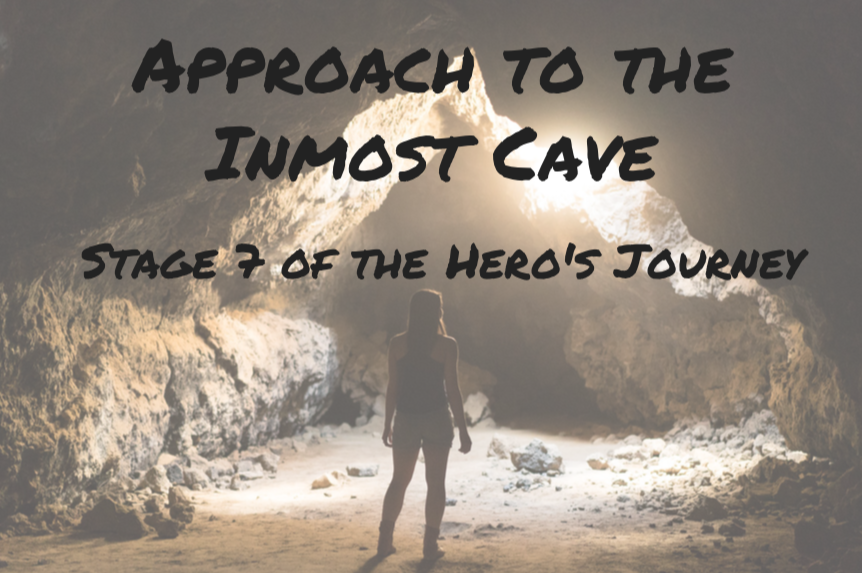Because everyone loves a good story
Stage Seven: Approach to the Inmost Cave

Woo-hoo! We’re past the halfway mark! I didn’t tell you when we were AT the halfway mark because that’s always a little disheartening, at least in workouts. (You mean I get to do the same amount of work that just nearly killed me, but with way less energy? Oh, goody.) So you, my friends, are MORE than halfway done with the Hero’s Journey! Don’t poop out now!
Last week we saw how the hero began to encounter Tests, Allies, and Enemies. But despite the risk of these encounters, the hero has not yet reached the ultimate test. No, this ultimate test still lies ahead, and to reach it, the hero must undergo the Approach to the Inmost Cave.
Setbacks while Approaching the Cave
If the Tests of the previous stage were difficult for the hero, the Approach should be even harder. Christopher Vogler explains that “heroes may have disheartening setbacks at this stage while approaching the supreme goal. Such reversals of fortune are called dramatic complications.” (152) Perhaps the hero’s secret weapon turns out to be ineffective. Maybe the team realizes they’ve gotten bad information. In the character department, it’s possible that the allies are afraid to step it up from “supportive friend” to “mighty warrior” status. The hero may even end up completely abandoned. “Though [these setbacks] may seem to tear us apart,” Vogler says, “they are only a further test of our willingness to proceed. They also allow us to put ourselves back together in a more effective form for traveling in this unfamiliar terrain.” (152)
If the Inmost Cave is where the greatest battle of the adventure takes place—whether physically or otherwise—then the approach to this Cave is a vital time of preparation. The hero has much to learn, acquire, decide, and prepare. Let’s consider a few examples.
Examples of Approaching the Cave
In Star Wars: The Empire Strikes Back, Luke Skywalker has been training with Master Yoda by running around a swamp and levitating rocks. He starts to feel pretty cocky about his new skillz, so he foolishly disregards Yoda’s counsel in order to “save” his friends. However, the impetuous little twerp steps right into Darth Vader’s trap. As he flies to Cloud City, he is approaching the Inmost Cave.
In Fahrenheit 451, Guy Montag is a “fireman” whose job it is to burn houses in which books are hidden. He’s been wrestling with the morality of his job, weighing the value of knowledge and free thought against the blissful ignorance of mindless entertainment. He knows a crisis of decision is coming, and it drives him to crazy behavior. He fakes an illness to avoid going to work. He reveals his own stash of hidden books to his brainless wife. He reads poetry to his wife’s equally-brainless friends. And he contacts the only ally he knows: a fearful old man that he’s only met once. But craziest of all, he decides to go back to work. Little does he know that, as he rides the fire engine to that night’s condemned house, he is riding to the Inmost Cave.
The Hobbit Is Approaching the Cave
By this stage, Bilbo and his companions have made it to the cave—the literal cave in which the dragon, Smaug, sleeps with the treasure that belongs to the dwarves. After they find the door, Bilbo volunteers to sneak a peek at the situation inside. Now, I think that Bilbo’s taking of the Arkenstone (Thorin’s most sought after gem) may fit in the stage called Reward or Seizing of the Sword, but that isn’t until two stages from now. Remember, these are common components of an adventure, not a formula to plug a plot into. The author can scramble or omit stages however he pleases, especially if he is J.R.R. Tolkien.
In The Hobbit, the inmost cave seems to be the literal cave full of treasure. However, the hardest part is not simply finding it (although that took more than half the book) but claiming it beyond dispute. Bilbo pulls a tricky maneuver and hands the Arkenstone over to the elves and men in hopes that this leverage will bring peace and avoid war. It doesn’t. Although Thorin and Company have claimed the cave, they have not yet faced the true Ordeal.
Today’s Question: Think of an Approach scene in an adventure story you know. What makes this an effective prelude for the Ordeal that follows?
Sources
Vogler, Christopher. The Writer’s Journey: Mythic Structure for Writers, Second Edition. Studio City: Michael Wiese Productions, 1998.
Tolkien, J.R.R. The Hobbit. New York: Ballantine Books, 1937.




Add a comment, and join the conversation!